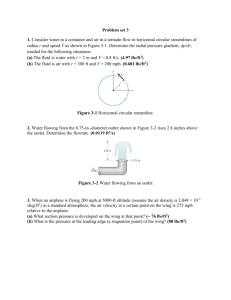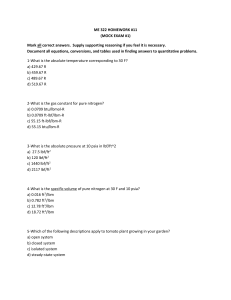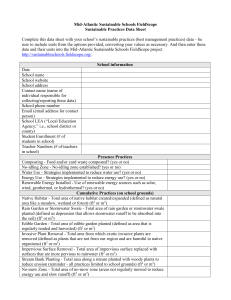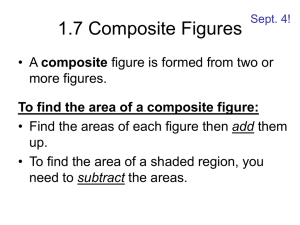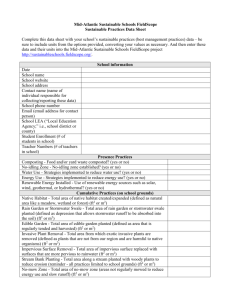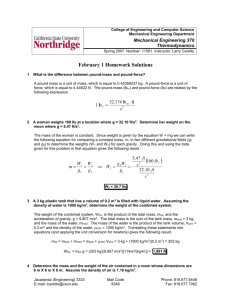Unit 9: April 10
advertisement
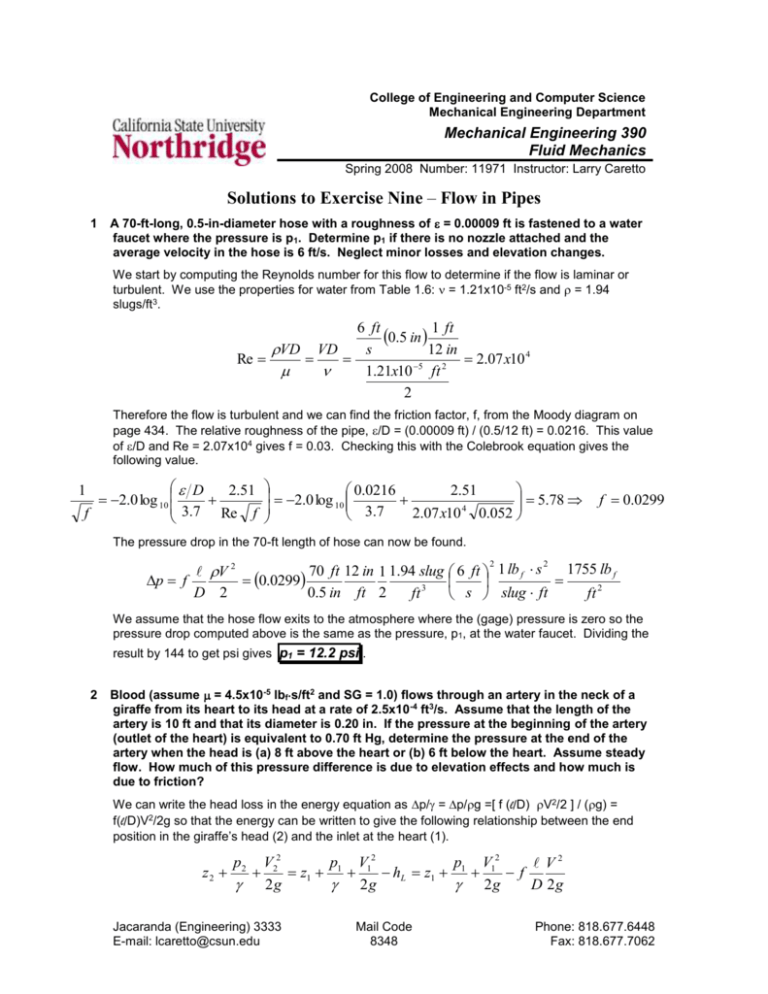
College of Engineering and Computer Science Mechanical Engineering Department Mechanical Engineering 390 Fluid Mechanics Spring 2008 Number: 11971 Instructor: Larry Caretto Solutions to Exercise Nine – Flow in Pipes 1 A 70-ft-long, 0.5-in-diameter hose with a roughness of = 0.00009 ft is fastened to a water faucet where the pressure is p1. Determine p1 if there is no nozzle attached and the average velocity in the hose is 6 ft/s. Neglect minor losses and elevation changes. We start by computing the Reynolds number for this flow to determine if the flow is laminar or turbulent. We use the properties for water from Table 1.6: = 1.21x10-5 ft2/s and = 1.94 slugs/ft3. 6 ft 0.5 in 1 ft s 12 in VD VD Re 2.07 x10 4 5 1.21x10 ft 2 2 Therefore the flow is turbulent and we can find the friction factor, f, from the Moody diagram on page 434. The relative roughness of the pipe, /D = (0.00009 ft) / (0.5/12 ft) = 0.0216. This value of /D and Re = 2.07x104 gives f = 0.03. Checking this with the Colebrook equation gives the following value. D 2.51 2.0 log 10 3.7 Re f f 1 2.51 2.0 log 10 0.0216 5.78 4 3 . 7 2 . 07 x 10 0 . 052 f 0.0299 The pressure drop in the 70-ft length of hose can now be found. 2 2 1755 lb f 70 ft 12 in 1 1.94 slug 6 ft 1 lb f s V 2 p f 0.0299 3 D 2 0.5 in ft 2 ft ft 2 s slug ft We assume that the hose flow exits to the atmosphere where the (gage) pressure is zero so the pressure drop computed above is the same as the pressure, p1, at the water faucet. Dividing the result by 144 to get psi gives p1 = 12.2 psi . 2 Blood (assume = 4.5x10-5 lbfs/ft2 and SG = 1.0) flows through an artery in the neck of a giraffe from its heart to its head at a rate of 2.5x10-4 ft3/s. Assume that the length of the artery is 10 ft and that its diameter is 0.20 in. If the pressure at the beginning of the artery (outlet of the heart) is equivalent to 0.70 ft Hg, determine the pressure at the end of the artery when the head is (a) 8 ft above the heart or (b) 6 ft below the heart. Assume steady flow. How much of this pressure difference is due to elevation effects and how much is due to friction? We can write the head loss in the energy equation as p/ = p/g =[ f (l/D) V2/2 ] / (g) = f(l/D)V2/2g so that the energy can be written to give the following relationship between the end position in the giraffe’s head (2) and the inlet at the heart (1). z2 p2 V22 p V2 p V2 V2 z1 1 1 hL z1 1 1 f 2g 2g 2g D 2g Jacaranda (Engineering) 3333 E-mail: lcaretto@csun.edu Mail Code 8348 Phone: 818.677.6448 Fax: 818.677.7062 Exercise nine solutions ME 390, L. S. Caretto, Spring 2008 Page 2 Since the area is assumed constant and the blood is assumed to have constant density, the velocity at all points in the artery is the same. Thus we can cancel the V12 and V22 terms and write the following equation for the pressure difference between the head (p 2) and the heart (p1). p2 p1 z1 z 2 f V2 D 2g To compute the friction factor we first compute the Reynolds number to determine if the flow is laminar or turbulent. Note that a specific gravity of 1 gives a density = 1.94 slug/ft3 and a specific weight of 62.4 lbf/ft3 for the blood. The diameter of 0.20 in = 0.01667 ft. giving a cross sectional area of D2/4 = (0.01667 ft)2/4 = 0.000218 ft2. We can compute the velocity from the flow rate: V = Q/A = (2.5x10-4 ft3/s) / (0.000218 ft2) = 1.146 ft/s. 1.94 slug 1.146 ft 0.01667 ft s VD ft 3 Re 823 4.5 x10 5 lb f s ft 2 Thus, the flow is laminar so f = 64/Re = 64/823 = 0.0777. We can now compute the head loss term. 2 1.146 ft 2 10 ft V s 0.9517 ft f 0.0777 32 . 174 ft D 2g 0.01667 ft 2 2 s The pressure at the start of the artery is given as equivalent to 0.70 ft of Hg. Multiplying this height by the specific weight of mercury, Hg = 847 lbf/ft3, from Table 1.5 gives p1 = 593 lbf/ft2. Substituting this value for p1 and the value of 0.9517 ft found for the head loss into the energy equation gives. V 2 593 lb f 62.4 lb f z1 z 2 0.9517 ft p2 p1 z1 z 2 f D 2 g ft 2 ft 3 When the head is 8 ft above the heart, z2 – z1 = 8 ft and the value of p2 is p2 593 lb f ft 2 62.4 lb f ft 3 z1 z 2 0.9517 ft 593 lb f ft 2 62.4 lb f ft 3 8 ft 0.9517 ft = 34.5 lb f ft 0.9517 ft = 908 lb f ft 2 When the head is 6 ft below the heart, z1 – z2 = 6 ft and the value of p2 is p2 593 lb f ft 2 62.4 lb f ft 3 z1 z 2 0.9517 ft 593 lb f ft 2 62.4 lb f ft 3 6 ft 2 In both cases, the head loss (due to frictional effects) is (0.9517 ft) = (0.9517 ft)(62.4 lbf/ft3) = 59.4 lbf/ft2. When the head is above the heart the initial pressure of 593 lbf /ft2 is reduced by 59.4 lbf/ft2 by frictional effects and an additional (8 ft)(62.4lbf/ft2) = 499 lbf/ft2 by the elevation change. When the head is 6 ft below the heart, the usual pressure change due to the elevation difference would be an increase of (6 ft)(62.4 lbf/ft2) = 374 lbf/ft2 from 593 lbf/ft2 to 967 lbf/ft2. However the friction loss decreases the actual pressure gain so that the pressure is only 908 lbf/ft2 in this case. Exercise nine solutions 3 ME 390, L. S. Caretto, Spring 2008 Page 3 Water flows downward through a vertical 10-mm-diameter galvanized iron pipe with an average velocity of 5.0 m/s and exits as a free jet. There is a small hole in the pipe 4 m above the outlet. Will water leak out of the pipe through the hole or will air enter into the pipe through the hole? Repeat the problem if the average velocity is 0.5 m/s. To answer this problem we have to find the pressure in the pipe at the location of the hole. If this pressure is greater than atmospheric pressure (zero gage pressure) then water will flow out the hole; if it is less, air will flow into the pipe. We can write the head loss, hL, in the energy equation as p/ = p/g =[ f (l/D) V2/2 ] / (g) = f(l/D)V2/2g so that the energy can be written to give the following relationship between the initial location at the hole (1) and the outlet flow at the bottom of the pipe(2). z2 p2 V22 p V2 p V2 V2 z1 1 1 hL z1 1 1 hs f 2g 2g 2g D 2g This pipe has no work effect so hs = 0. Since the area is assumed constant for the pipe and the water has constant density, the velocity at all points in the pipe is the same. Thus we can cancel the V12 and V22 terms. Furthermore the outlet pressure is a free jet so, p2 = 0. This leaves the following result for the pressure at the hole, p1. V 2 p1 z 2 z1 f D 2 g We start by computing the Reynolds number for this flow to determine if the flow is laminar or turbulent. We use the properties for water from Table 1.6: = 1.12x10-6 ft2/s. Re VD VD 5m 10 mm 1 m s 1000 mm 1.12 x10 s 6 m 2 4.45 x10 4 We find the relative roughness for the galvanized iron pipe from Table 8.1: = 0.15 mm so that /D = (0.15 mm)/(10 mm) = 0.015. From the Moody diagram, for these values of /D and Re, we read f = 0.045. Checking this with the Colebrook equation gives the following value. D 1 2.51 2.0 log 10 f 3.7 Re f 2.51 2.0 log 10 0.015 5.78 3.7 4 4 . 45 x 10 0 . 045 f 0.0447 Using the friction factor and the elevation difference, z2 – z1 = –4m can now compute p1. 2 V 2 9800 N 4 m 5 m 1 s 2 1.86 x105 N p1 z 2 z1 f 4 m 0.045 D 2 g 0.01m s 2 9.81 m m3 m2 Since p1 is greater than zero water will leak out of the hole . We have the same calculations if V = 0.5 m/s. Exercise nine solutions Re ME 390, L. S. Caretto, Spring 2008 VD VD 0.5 m 10 mm 1 m s 1000 mm 1.12 x10 s 6 m 2 Page 4 4.45 x103 For this Reynolds number and e/D = 0.015 we find f = 0.052 from the Moody diagram. Checking this with the Colebrook equation gives. D 1 2.51 2.0 log 10 3.7 Re f f 2.51 2.0 log 10 0.015 5.78 3 4.45 x10 0.052 3.7 V 2 9800 N p1 z 2 z1 f D 2 g m3 f 0.0524 2 4 m 0.5 m 1 s 2 3.66 x10 4 N 4 m 0.052 0.01m s 2 9.81 m m2 Since p1 is less than zero air will leak into the pipe .
